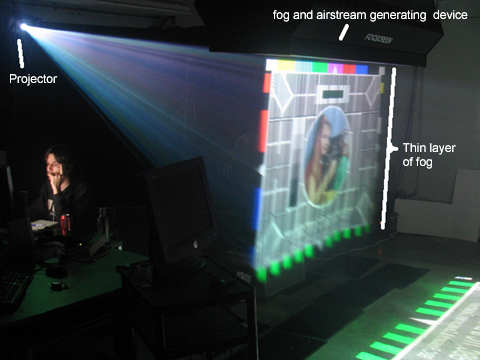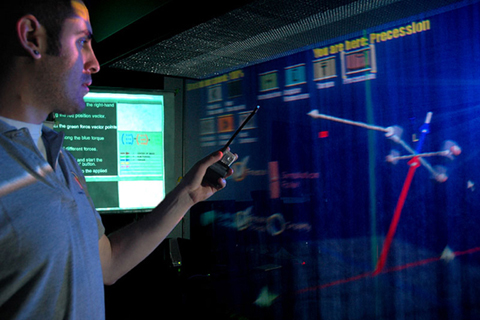Related Categories: Immersive Text Environments, Hardware Innovations
Summary:
The FogScreen is an innovative display technology that allows for projections on a thin layer of dry fog. Imagine the traditional pull down screen that is found in many classrooms today. Instead of a screen being pulled down from the ceiling, fog is pushed down and held in place by several small fans, allowing for a consistent surface for display. A user may simply stand back and view the material but can also reach or walk through the fog. A user may also interact with objects displayed in the fog with the use of an input device like a data glove, a tracked wand, or simply using hands (see Technical Analysis). Currently, there are only nine FogScreens available in the world. Most of the FogScreens are used as a novel display technology for businesses looking to attract visitors at conventions, or by artists / musicians as part of their entertainment shows. However, research is being conducted in attempts to find ways that the FogScreen can be used as an educational tool. In this report, we describe the FogScreen experience itself and the findings made when deploying LEMMA (Learning Environment with Multi-Media Augmentations) on the FogScreen. Due to extreme financial and spatial efforts of the device, it is unlikely that the average citizens will be able to interact with such a technology, but there are hopes of creating smaller, less expensive FogScreens, or similar devices, in the near future.
Description
The FogScreen Hardware Components:
- Fog Machine
- Large Fog Display Carrier which houses the fans and pushes down the fog
(attached to the ceiling) - Projector(s)
For interactivity additionally the following components are required:
- Input device (data glove, wand etc.)
- Tracker or Range Scanner
As stated in the summary, the FogScreen is a display technology that instead of using a traditional screen, uses a thin layer of dry fog as the display surface. The system starts with water that is held in a large plastic container or comes from a regular water pipe. This water is drawn through a plastic tube via a small engine. Users have the ability to control the density and flow of the fog and the strength of the sandwiching airstreams.
Once the fog has been created, it is then pushed from the large, hardware system (6×3 x 3, 200 lb) that hangs from the ceiling. Within this hardware there are several small fans that are used to push the fog down, and control its form. These fans allow the fog to stay in a nice, thin layer. Once the fog hits the floor, it dissipates. Only after an hour or so of constant use does a layer of moisture begin to build up on the floor and occasional dripping can occur.
The actual size of the screen of fog is about 6 feet wide by 4.5 feet tall. Of course a user can control the size of the display by either manipulating the projector or the computer providing the information to the projector.
Other hardware that must be used with the FogScreen is a projector. A projector is used just as it is currently used in traditional classrooms on pull-down screens. However, two projectors may be used on either side of the FogScreen because of the fog’s ability to scatter light rather than reflecting it. Users on either side of the fog may be interacting with different objects and not impede the other’s view.
In order to interact with virtual objects, users must have an input device. This input device must provide an infrared light so trackers may be able to locate the user’s location.
Reading in an Immersive FogScreen Environment:
Deploying LEMMA in coursework yielded some first results about how the FogScreen can be used for content transfer. The purpose of LEMMA is to allow educators without programming knowledge to create tutorials that incorporate text, voice, and image/object display. LEMMA was recently applied in a project that used tutorial-based instruction and the display abilities of the FogScreen to teach physics students at UCSB common concepts like torque, precession, and angular momentum.
During the first user study with LEMMA we found that using the FogScreen for transferring content to a “reader” can be beneficial in various ways and also has some obvious drawbacks. Speaking of the latter, mainly the blurriness of text on the fog is straining for the reader. Besides that, as the image on the screen is sharpest when the eyes are in line with the light rays from the projector, but looking directly into the projector is difficult. The physical interaction with the content can be tiring, but it also has the positive effect of linking the content to whole body motion. The greatest advantage that the FogScreen shares with most other computer displays is the capability of enhancement by other media (audio, pictures…). Furthermore, it even provides an immersiveness to the user without having to wear extra hardware like a Head Mounted Display. Due to its translucency, immaterialness and two-sidedness, it can also provide a whole new experience in collaborative reading. Because it is possible to view different material on either side of the FogScreen without impeding the other user’s view, it is possible that multiple users could be interacting with, and thus reading, multiple objects simultaneously.
Research Context:
The FogScreen is an important piece of technology that allows for new ways of displaying information for users. This type of technology is of interest to the transliteracies group because it allows users to interact with, read and interpret, virtual objects in a mixed-reality environment. The environment is not completely virtual because the user can see and interact with real objects in and around the fog. For example, in our study users interacted with the FogScreen as well as another side display. They still used their “real” hands, not needing a virtual representation of it. Also, objects on the opposite side of the user, like maybe a physical model of a molecule, could be overlayed with augmentations like bonds or labels. Contrasting that, the FogScreen is not a pure augmented reality environment either. Augmented reality allows for virtual objects to be displayed on the real world, thus making the real world the user’s interface. This is also possible with the FogScreen like it would be on a see-through display, used for example in clinical augmented reality applications. The main difference is the stationary character of the device, demanding another kind of interaction scheme as it cannot be “moved” in front of real world objects. Concluding the FogScreen may be labeled as allowing users to interact in a mixed-reality environment.
Because the FogScreen allows for an innovative way of displaying information, users of the FogScreen must also develop new ways of reading the information available. The information is not displayed in a traditional 2D environment, but not a pure 3D environment either. And, users are able to physically interact with the objects being displayed. How users handle the cognitive load in this environment, and how well the physicality aspect of the displays assist in learning are still unknown. However, initial findings suggest that users are able to quickly become comfortable in this environment, and the FogScreen’s enhanced reality environment is an excellent tool for displaying abstract information in more concrete terms. More research is needed to better understand how users interpret information, use that interpreted information to solve or understand larger concepts, and how users replicate that information outside of the FogScreen environment.
Enhanced reality environments will become part of our daily interactions in the near future. It is important to understand how users gather, interpret, make meaning of, and use information displayed in mixed, virtual, and augmented reality environments.
Technical Analysis:
The FogScreen is a thin (1-3 inch) layer of fog on which a LCD projector projects an image, usually but not necessarily, generated by a computer. The projector does not need to be specialized in any way, except that it needs the ability to mirror the image since rear projection is applied. This is because the fog scatters the light rather than reflects it. The image on the “projector” side of the screen is therefore very dim, an issue, that actually enables the use of two projectors, one on either side of the screen. This means it is possible to project, for example, the same scene viewed from opposed standpoints on the two sides, generating “almost” real 3D, as you can examine the same object from two sides by just walking around or through it.
The fog is produced from pure water and therefore completely non-hazardous. It also is dry to the touch and neither very cold or hot. It is produced by floating water over devices that make use of membranes that oscillate in the frequency of ultrasound, therefore evaporating the water. The produced fog is then blown downward in front of the user by adjustable fans. The overall novelty of the FogScreen is an airflow (also produced by adjustable fans) on both sides of the fog, having the effect of “sandwiching” the fog between them and therefore stabilizing the screen. A technical problem of the FogScreen is the non-zero thickness of the fog, causing rays of light to smear across this thickness. This means that pixels that are seen from the side, rather than directly from the front, are blurry, making text especially difficult to read. At the time of this writing only nine FogScreens exist worldwide and one costs around $100,000.
For interactivity with the FogScreen, a tracker has to be used. Using a laser range scanner enables interactivity even without additional handheld hardware. Drawbacks include a limitation to two dimensions and disturbance due to the fog interfering with the laser beams. A better, but more expensive solution is to use an infrared tracker, like the WorldViz PPT Tracker, that was used in the set up during our study. In this case four cameras search for an infrared LED the user holds in his hand. From the camera’s images, the location of the LED is calculated in three dimensions with an accuracy around 1/5 inch. We combined such an LED with a regular wireless mouse, providing buttons as a familiar way of interacting with objects on the screen. The LEMMA software application can therefore be aware of the users hand location in space and the status of the three mouse buttons. For this reason, the interactable items of LEMMA not only include common buttons, checkboxes and sliders, but also introduce more spatial interaction though items like draggers (handles for moving objects three dimensions) and vector controllers (items for generating vectors for e.g. forces in three dimensions).

Evaluation of Opportunities and Limitations for Transliteracies Project:
Because the FogScreen is available on the UCSB campus, opportunities for research are much easier. Especially the option of collaborative reading would be worth further research. However, as stated earlier, there are only nine FogScreens in the world today. Also, since the FogScreen is a technology that only displays information, a computer scientist, graphic designer, technical communicator, educator, or someone with related skills will be needed to create information to be displayed.
Research for Further Study:
- The FogScreen Homepage
- The FogScreen project page
- LEMMA project page
- Mayer, R. E. Mayer’s Modality Principle. Multimedia Learning, Cambridge University Press, New York, 2001.


August 8th, 2008 at 8:51 am
Visit UK Fogscreen at http://ukfogscreen.com or http://skad.co.uk for more info.
March 4th, 2009 at 4:18 am
hiii,
dis is Neethu..am doin my final year engg in ISE….as part of my academics i need to give a seminar in d coming week..d topic “FOG SCREEN” interests me a lot n i wud like to give d seminar on d same topic..
pls do send me d ppts n pdf…i ll be very thankful to u…
regards
-Neethu